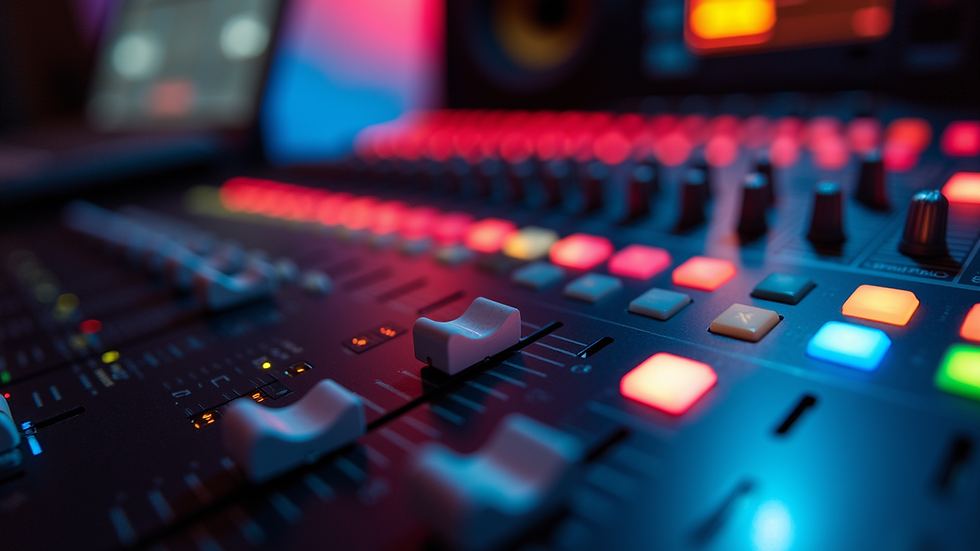Advanced Music Production Techniques for Modern Sound
- jeddemlow
- Oct 27
- 4 min read
Creating music today is an exciting journey. With so many tools and techniques available, it’s easier than ever to craft professional-quality tracks. But standing out requires more than just basic skills. You need to dive deeper into the craft. That’s where advanced music production tips come in. These tips will help you elevate your sound and bring your musical ideas to life with clarity and impact.
Let’s explore some practical ways to enhance your music production process. Whether you’re working in a home studio or a professional setup, these insights will guide you toward a polished, modern sound.
Essential Music Production Tips for Better Tracks
Starting with the basics is important, but refining your workflow and sound design can make a huge difference. Here are some key music production tips that I find invaluable:
Organize your session: Label tracks clearly and group similar instruments. This saves time and keeps your project manageable.
Use reference tracks: Compare your mix to professional songs in the same genre. This helps you understand balance, tone, and loudness.
Layer sounds carefully: Instead of relying on one instrument, layer multiple sounds to create depth and richness.
Apply EQ with purpose: Cut unwanted frequencies before boosting others. This keeps your mix clean and prevents muddiness.
Automate effects and volume: Dynamic changes keep the listener engaged and add emotion to your track.
For example, when mixing vocals, I often use a high-pass filter to remove low rumble and then gently boost the presence range around 3-5 kHz. This makes the vocals clear without harshness.

How to Make Music Production More Interesting?
Keeping your production process fresh and exciting is key to staying motivated. Here are some ways to make music production more interesting:
Experiment with sound design: Try creating your own synth patches or manipulating samples in unusual ways.
Use unconventional instruments: Incorporate sounds from everyday objects or field recordings to add unique textures.
Change your workflow: Switch the order of your production steps. For example, start with drums or vocals instead of chords.
Collaborate with others: Working with different musicians or producers can spark new ideas and perspectives.
Set creative limitations: Limit yourself to a few plugins or instruments. Constraints often lead to more creative solutions.
I like to challenge myself by using only one synth and one drum machine for an entire track. It forces me to dig deeper into sound design and arrangement.
Using Effects Creatively to Shape Your Sound
Effects are powerful tools that can transform your music. Beyond basic reverb and delay, there are many ways to use effects creatively:
Parallel processing: Send a copy of your track to a separate bus with heavy compression or distortion, then blend it back with the dry signal for added punch.
Automation of effects parameters: Slowly increase reverb size or delay feedback during a breakdown to build tension.
Modulation effects: Use chorus, flanger, or phaser subtly to add movement and interest to static sounds.
Granular synthesis and glitch effects: Chop and rearrange audio fragments for experimental textures.
For instance, I often automate a filter cutoff on a synth pad to create evolving soundscapes that keep the listener hooked.

The Role of Arrangement in Modern Music Production
A great arrangement can make or break a track. It’s not just about the sounds you choose but how you structure them over time. Here are some arrangement tips:
Build tension and release: Use dynamics, instrumentation, and effects to create peaks and valleys.
Keep it simple: Avoid overcrowding your arrangement. Space allows each element to shine.
Use variation: Change drum patterns, add fills, or switch up melodies to maintain interest.
Create transitions: Use risers, sweeps, or breaks to smoothly move between sections.
When arranging, I often start with a strong intro and gradually introduce new elements. This helps listeners ease into the track and stay engaged.
Tips for Mixing and Mastering Like a Pro
Mixing and mastering are the final steps that give your music a professional finish. Here’s how to approach them:
Mix in stages: Start with balancing levels, then move to EQ, compression, and effects.
Use reference monitors or headphones: Make sure your mix translates well on different playback systems.
Leave headroom: Keep your mix peaks around -6 dB to allow space for mastering.
Master with subtlety: Apply gentle compression, EQ, and limiting to enhance loudness without squashing dynamics.
Remember, less is often more. Over-processing can kill the vibe of your track.
If you want to dive deeper into advanced music production techniques, I highly recommend checking out resources and studios that specialize in helping emerging artists. They offer full production services and tools designed to bring your musical vision to life with professional polish.
By applying these tips and staying curious, you’ll continue to grow as a producer and create music that truly stands out. Keep experimenting, learning, and most importantly - enjoy the process!




Comments